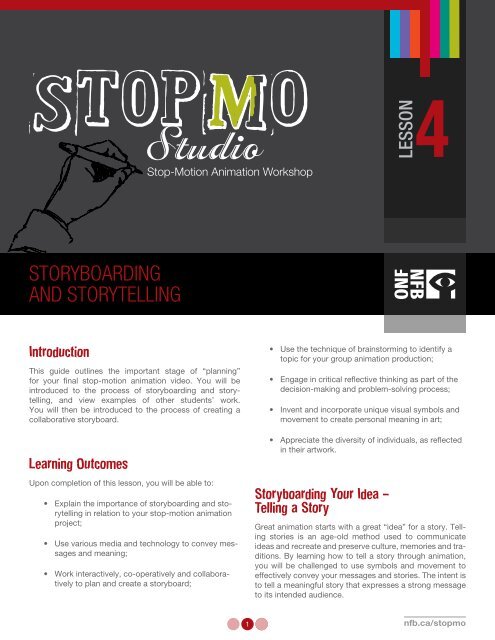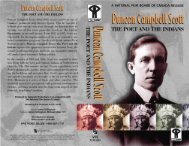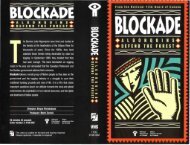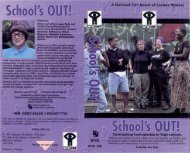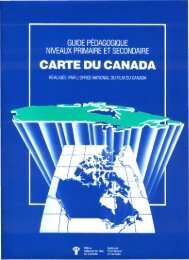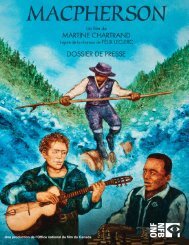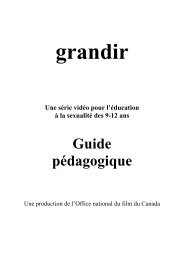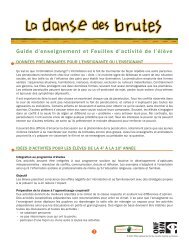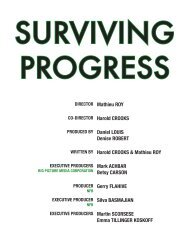STORYBOARDING AND STORYTELLING
STORYBOARDING AND STORYTELLING
STORYBOARDING AND STORYTELLING
Create successful ePaper yourself
Turn your PDF publications into a flip-book with our unique Google optimized e-Paper software.
LESSON<br />
4<br />
Stop-Motion Animation Workshop<br />
Storyboarding<br />
and Storytelling<br />
Introduction<br />
This guide outlines the important stage of “planning”<br />
for your final stop-motion animation video. You will be<br />
introduced to the process of storyboarding and storytelling,<br />
and view examples of other students’ work.<br />
You will then be introduced to the process of creating a<br />
collaborative storyboard.<br />
Learning Outcomes<br />
Upon completion of this lesson, you will be able to:<br />
• Explain the importance of storyboarding and storytelling<br />
in relation to your stop-motion animation<br />
project;<br />
• Use various media and technology to convey messages<br />
and meaning;<br />
• Work interactively, co-operatively and collaboratively<br />
to plan and create a storyboard;<br />
• Use the technique of brainstorming to identify a<br />
topic for your group animation production;<br />
• Engage in critical reflective thinking as part of the<br />
decision-making and problem-solving process;<br />
• Invent and incorporate unique visual symbols and<br />
movement to create personal meaning in art;<br />
• Appreciate the diversity of individuals, as reflected<br />
in their artwork.<br />
Storyboarding Your Idea –<br />
Telling a Story<br />
Great animation starts with a great “idea” for a story. Telling<br />
stories is an age-old method used to communicate<br />
ideas and recreate and preserve culture, memories and traditions.<br />
By learning how to tell a story through animation,<br />
you will be challenged to use symbols and movement to<br />
effectively convey your messages and stories. The intent is<br />
to tell a meaningful story that expresses a strong message<br />
to its intended audience.<br />
1<br />
1<br />
nfb.ca/stopmo
Stop-Motion Animation Workshop<br />
LESSON<br />
4<br />
Storyboarding and Storytelling<br />
Individual Learning Activity:<br />
Storytelling and Inspiration<br />
Frédéric Back, author of the acclaimed, Oscar-winning<br />
animated film The Man Who Planted Trees, is an inspirational<br />
figure. His work is an expression of his dedication<br />
to a message of peace and respect for the Earth and its<br />
communities. Back has created several outstanding animated<br />
films that can inspire your students to tell their own<br />
meaningful stories. The web pages below explore how his<br />
passion for the environment led Back to make animated<br />
films in the hope of making this world a better place.<br />
fredericback.com/ateliers/index3.en.shtml. (See themes<br />
6 and 7).<br />
All animation productions (and many live-action productions)<br />
begin life as a storyboard, which is a script of sorts<br />
written with images as well as words, similar to a giant<br />
comic strip. Storyboarding includes scene planning, which<br />
requires you to plan out the scenes of your movie from start<br />
to finish before you begin animating. Your storyboards will<br />
incorporate the key poses in the story; in-betweens can<br />
be incorporated later. Your group will need to figure out<br />
the acting and timing requirements for each scene. Please<br />
ensure that your group devises a distinct beginning, middle<br />
and end to your story. Remember, the better you plan, the<br />
better your animated video will be!<br />
To learn about storyboarding at the NFB, watch the following<br />
video:<br />
Storyboarding Your Idea<br />
(4 min 30 s)<br />
To view the storyboard examples found in the video, click<br />
on the NFB Mediatheque Storyboard Sheet and NFB Completed<br />
Storyboard.<br />
Introduction to Teamwork<br />
and Brainstorming<br />
You will create your movies in collaborative teams. Your<br />
teacher will assign you to a Production Team of four to six<br />
people for the conceiving, planning and production stages<br />
of the studio portion of the stop-motion animation lessons.<br />
All teams are expected to work in a respectful and collaborative<br />
fashion. Each team member should participate<br />
equally and share tasks. As each team member will bring<br />
their own unique expertise and talents to the group, everyone’s<br />
ideas and contributions to the project are to be<br />
considered valuable. If you work together effectively, are<br />
committed to the project and use your group’s diversity of<br />
skills, your team’s final product will likely be much better<br />
than if you had completed the project on your own!<br />
The Stop-Motion Animation Rubric see Annex 01 provides<br />
guidelines for your team and identifies how each section of<br />
the production process will be graded. The high percentage<br />
allocation for the teamwork component of this rubric<br />
reflects the view that strong teamwork skills are deemed<br />
essential to working successfully in the competitive real<br />
world of animated film production.<br />
Group Learning Activity: Brainstorming a Topic<br />
Your first task as a team is to effectively brainstorm ideas<br />
to help in the selection of a good topic for your animated<br />
video. Please identify relevant themes from the following<br />
list of subjects.<br />
• English<br />
• Science<br />
• Health<br />
• Technology<br />
• Math<br />
• Social Studies<br />
• Arts (Art, Music, Theatre)<br />
• Media Literacy<br />
(for advanced curriculums—<br />
grades 7 and up)<br />
Some popular and relevant themes identified for your age<br />
group include:<br />
• Bullying<br />
• The Environment<br />
• Substance Abuse • Active Healthy Lifestyles<br />
• Racism,<br />
Diversity & Body Image<br />
You may choose a topic from the above themes, or think up one of your own. The Thought Bubble below may help you brainstorm.<br />
Once your team identifies a theme, you may want to research it on the Internet to help you come up with a specific<br />
idea for your animation. The idea that you select should be interesting and meaningful to all team members.<br />
Note: Please take your time when devising your topic and story for your animated video, as this initial decision will affect<br />
all other steps of the production process!<br />
“endangered species” “ocean” “marine life” “life” “death”<br />
“endangered “pregnancy” species” “birth” “ocean” “teen pregnancy” “marine life” “marriage” “life” “death” “friendship” <br />
“pregnancy” “birth” “teen pregnancy” “marriage” “friendship” <br />
“family”<br />
“family” “war”<br />
“war”<br />
“peace”<br />
“peace”<br />
“gravity”<br />
“gravity”<br />
“electricity”<br />
“electricity”<br />
“pulleys<br />
“pulleys<br />
& levers”<br />
& levers”<br />
<br />
“tsunamis” “earthquakes” “equilibrium” “microscopes” “bacteria” <br />
“nuclear energy” “mutations” “sickness” “disease” “cures” “AIDS” “AIDS” <br />
“magic” “legends” “fantasy” “fables” “myths” “witches” “witches” “fairies” “fairies” <br />
“leprechauns” “metamorphosis” “ecosystems” “lightning” <br />
“leprechauns” “metamorphosis” “ecosystems” “lightning”<br />
“icebergs” “polar bears” “traditions” “whales” “hunting” “fishing” <br />
“icebergs” “trapping” “polar “sports” bears” “murmuring” “traditions” “sealing” “whales” “special “hunting” occasions” “f ishing”<br />
“trapping” “peer pressure” “sports” “discoveries” “murmuring” “famous “sealing” events” “special “outer occasions” space” “peer<br />
pressure” “wonders “discoveries” of the world” “planets” “famous events” “stars” “black “outer holes” space” “mountains” “wonders of<br />
“forests” “waterfalls” “music” “occupations” “poverty” <br />
the world” “planets” “stars” “black holes” “mountains”<br />
“forests” “waterfalls” “music” “occupations” “poverty”<br />
world leaders heros role models famous people <br />
I am brainstorming<br />
nfb.ca/stopmo<br />
2 2<br />
3<br />
nfb.ca/stopmo
Stop-Motion Animation Workshop<br />
Storyboarding and Storytelling<br />
Creating a Collaborative Storyboard<br />
Once your team has come up with a potential topic for<br />
your animation, you will need to have your idea approved<br />
by your teacher. Once given the go-ahead, your group will<br />
need to begin storyboarding.<br />
Learning Activity: Cartoon Animation<br />
Watch the following NFB video to learn how an artistic animated<br />
film is made and to get an idea of the enormous time<br />
commitment involved in storyboarding.<br />
Sleeping Betty: Interview with Claude Cloutier<br />
(2007, 4 min 32 s)<br />
]<br />
nfb.ca/film/sleeping_betty_interview<br />
Synopsis: Animator and director Claude Cloutier talks<br />
about his film, Sleeping Betty, and the process of animation.<br />
(Recommended for grades 7 and up.)<br />
Storyboard Websites<br />
To see examples of the intricacy of storyboards made by<br />
professional artists, please visit the following websites:<br />
Stephen McCallum’s Animation/Media Production<br />
]<br />
stephenmccallum.blogspot.com/2009/07/storyboards.html<br />
(Storyboard for the NFB’s From Flores, 1991)<br />
Michael Sporn Animation, Inc.<br />
]<br />
michaelspornanimation.com/splog/?p=1536<br />
]<br />
michaelspornanimation.com/splog/?cat=2<br />
(Storyboards from the Disney classics Sleeping<br />
Beauty and Cinderella)<br />
The Necktie: Animated Storyboard (2008, 1 min 27 s)<br />
]<br />
nfb.ca/film/necktie_animated_storyboard<br />
Learning Activity:<br />
Creating Your Storyboard<br />
You may use a copy of the NFB Storyboard Sheet to<br />
help plan out your storyboard, use storybook templates<br />
found on the Internet or create your own storyboards from<br />
scratch. Keep your story and message simple and concise,<br />
as it takes 24 frames to make up one second of animation.<br />
The process will likely take longer than you might think.<br />
Note: The average animated movie length will vary and depend<br />
upon topic selection and length of class time. Your<br />
teacher will help each class group determine an appropriate<br />
run time.<br />
Use this Storyboard Rubric to ensure that your team includes<br />
all information and components when designing<br />
and completing your storyboard.<br />
Questions you might want to consider include:<br />
• What is your setting?<br />
• How many characters do you need in the shot?<br />
• Do you need any important props in the shot?<br />
• What type of shot (close-up, wide shot,<br />
establishing shot, etc.) do you need?<br />
• What is the shot’s angle (i.e., how/where is the<br />
camera positioned)?<br />
• Do you need any special lighting? The lighting<br />
depends on what type of mood you’re trying to<br />
convey (for example, you may need candlelight,<br />
moonlight, a dark alley or a bright sunny day).<br />
• Will you use any special effects?<br />
nfb.ca/stopmo<br />
4 4
Stop-Motion Animation Workshop<br />
Stop-Motion Animation Rubric<br />
LESSON<br />
4<br />
ANNEX 01<br />
Remember, all great stories start with a great idea. Great stories make great animation.<br />
Excellent<br />
Very<br />
good<br />
Good<br />
Needs<br />
Improvement<br />
Mark<br />
%<br />
Idea for<br />
story<br />
The idea for the story<br />
was excellent.<br />
Message extremely<br />
clear.<br />
The idea for the story<br />
was very good. Message<br />
very clear.<br />
The idea for the story<br />
was good. Message<br />
fairly clear.<br />
The idea for the story<br />
needs work. Message<br />
is unclear.<br />
15%<br />
Storyboard<br />
Extremely well<br />
planned—excellent<br />
flow.<br />
Drawings extremely effective<br />
in conveying the<br />
actions and emotions<br />
of story.<br />
Well planned—very<br />
good flow.<br />
Drawings very effective<br />
in conveying actions<br />
and emotions of story.<br />
Fairly well planned—<br />
good flow.<br />
Drawings fairly effective<br />
in conveying actions<br />
and emotions of story.<br />
More planning required—flow<br />
needs<br />
work.<br />
Actions and emotions<br />
of story not clearly conveyed<br />
in drawings.<br />
15%<br />
Characters<br />
Characters are extremely<br />
interesting—<br />
excellent effort.<br />
Characters are<br />
extremely suitable to<br />
storyline.<br />
Characters are very<br />
interesting—very good<br />
effort.<br />
Characters are very<br />
suitable to storyline.<br />
Characters are interesting—good<br />
effort.<br />
Characters are suitable<br />
to storyline.<br />
Characters are vague—<br />
more effort required.<br />
Characters’ suitability<br />
to storyline is unclear.<br />
10%<br />
Set/<br />
Props<br />
The set/props do<br />
an excellent job of<br />
enhancing the production’s<br />
aesthetics and<br />
mood.<br />
The set/props do a very<br />
good job of enhancing<br />
the production’s aesthetics<br />
and mood.<br />
The set/props do a fair<br />
job of enhancing the<br />
production’s<br />
aesthetics and mood.<br />
The set/props need effort<br />
to help enhance the<br />
production’s aesthetics<br />
and mood.<br />
5%<br />
Design<br />
Students display<br />
excellent knowledge of<br />
design elements.<br />
Students display very<br />
good knowledge of<br />
design elements.<br />
Students display fairly<br />
good knowledge of<br />
design elements.<br />
Students’ knowledge of<br />
design elements<br />
lacking.<br />
10%<br />
Movie<br />
Production<br />
Movement in the movie<br />
is very smooth.<br />
An excellent attempt to<br />
incorporate “principles<br />
of animation” and/or<br />
“tricks” into movie.<br />
Movement in the movie<br />
is smooth.<br />
A very good attempt to<br />
incorporate “principles<br />
of animation” and/or<br />
“tricks” into movie.<br />
Movement in the movie<br />
is generally smooth.<br />
A good attempt to<br />
incorporate “principles<br />
of animation” and/or<br />
“tricks” into movie.<br />
Movement in the movie<br />
is irregular/jumpy.<br />
The incorporation of<br />
the “principles of animation”<br />
and/or “tricks”<br />
is not apparent.<br />
15%<br />
Creativity<br />
Extremely creative<br />
work.<br />
Work is very creative.<br />
Work is creative.<br />
More thought and creative<br />
effort required.<br />
10%<br />
Teamwork<br />
The team worked<br />
extremely well<br />
together—shared tasks<br />
and activities.<br />
The team worked very<br />
well together—shared<br />
tasks and activities.<br />
The team worked well<br />
together—shared most<br />
tasks and activities.<br />
The team had difficulties<br />
working together<br />
and sharing tasks and<br />
activities.<br />
20%<br />
Total /100<br />
5 nfb.ca/stopmo
Stop-Motion Animation Workshop<br />
NFB STORYBOARD SHEET<br />
LESSON<br />
4<br />
ANNEX 02<br />
TITLE:<br />
ANIMATION TEAM:<br />
BEGINNING<br />
DESCRIPTION<br />
MIDDLE<br />
DESCRIPTION<br />
END<br />
DESCRIPTION<br />
6 nfb.ca/stopmo
Stop-Motion Animation Workshop<br />
STORYBOARD EXAMPLE<br />
LESSON<br />
4<br />
ANNEX 03<br />
7 nfb.ca/stopmo
Stop-Motion Animation Workshop<br />
Storyboard Rubric<br />
LESSON<br />
4<br />
ANNEX 04<br />
ALL STORYBOARDS START WITH A GOOD IDEA FOR A STORY.<br />
Excellent<br />
Very<br />
good<br />
Good<br />
Needs<br />
Work<br />
Mark<br />
%<br />
Scene<br />
Selection<br />
All main events of<br />
the story are identified<br />
through choice of<br />
scene selection.<br />
Most main events of<br />
the story are identified<br />
through choice of<br />
scene selection.<br />
Some main events of<br />
the story are identified<br />
through choice of<br />
scene selection.<br />
The main focus<br />
of the story is on “non<br />
essential events”; some<br />
scenes are incomplete.<br />
/4<br />
Captions<br />
Captions clearly identify<br />
each scene and<br />
help to connect the<br />
storyline.<br />
Most captions clearly<br />
identify each scene and<br />
help to connect the<br />
storyline.<br />
Some captions clearly<br />
identify each scene and<br />
help to connect the<br />
storyline.<br />
Captions don’t clearly<br />
identify each scene<br />
or help connect the<br />
storyline.<br />
/4<br />
Characters<br />
All main characters are<br />
identified; their actions<br />
and emotions match<br />
the storyline extremely<br />
well.<br />
All main characters are<br />
identified; their actions<br />
and emotions match<br />
the storyline very well.<br />
All main characters<br />
are identified, but their<br />
actions and emotions<br />
don’t always match the<br />
storyline.<br />
The main characters<br />
are not well identified;<br />
their actions and<br />
emotions are unclear in<br />
relation to the storyline.<br />
/4<br />
Set and<br />
Props<br />
The set/props relate<br />
extremely well to the<br />
purpose, mood and<br />
coherence of the story.<br />
The set/props relate<br />
very well to the purpose,<br />
mood and coherence<br />
of the story.<br />
Some of the set/props<br />
relate fairly well to the<br />
purpose, mood and<br />
coherence of the story.<br />
There is difficulty relating<br />
the set/props to the<br />
purpose, mood and<br />
coherence of the story.<br />
/4<br />
Thinking<br />
Skills<br />
All ideas are generated<br />
and organized in a logical<br />
sequence.<br />
The plot is quite original<br />
and creative. The message<br />
is very clear.<br />
Most ideas are generated<br />
and organized in a<br />
logical sequence.<br />
The plot is very original<br />
and creative. The message<br />
is clear.<br />
Some ideas aren’t generated<br />
and organized in<br />
a logical sequence. The<br />
plot is fairly original and<br />
creative. The message<br />
is somewhat clear.<br />
Most ideas are not generated<br />
and organized<br />
in a logical sequence.<br />
The originality and<br />
creativity of the plot is<br />
lacking. The message<br />
is unclear.<br />
/4<br />
Total /20<br />
8 nfb.ca/stopmo


